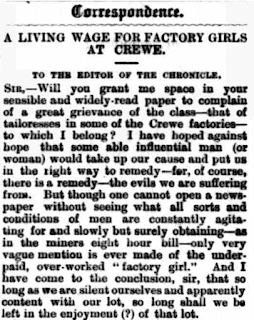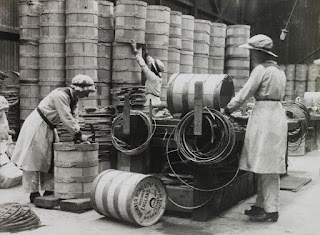You will go back a long way to find your first significant woman in Cheshire history and Aethelflaed, Saxon Lady of Mercia, rebuilding Chester in 907, but to make it onto our list you need to find their stories in our archives...
Cooking the books
Elizabeth Raffald honed her skills in domestic service for 15 years. Her final job was housekeeper at Arley Hall in Cheshire before she married and went on to be a formidable businesswoman with a keen eye for an opportunity in 18th century Manchester.
She ran a cookery school, domestic
staff agency, delivered high end dining to Manchester’s new money homes, used the
information she collected to publish Manchester’s first trade directory listing
businesses, services and potential clients. And in 1769 published the first
cookbook in English of original recipes – 800 of them – we made and loved
eating her Herb Pie.
For the record
Women appear equally in official records but these are bare glimpses and hints at lives lived. Take Parish registers recording baptisms, marriages and burials since the 1500s. In Taxal in 1707 there is a record of Hannah Wright and Anne Gaskill marrying, and in 1750 in Middlewich Maria Sproston marries Sarah Richardson 'commonly called Peter' – of course we will never know the whole stories, but this doesn’t make them any less fascinating.
We have managed to put some flesh on the bones of the life of a
woman whose headstone has become famous in Overleigh Cemetery in Chester. Mary Jonas ‘the mother of 33 children by one husband’ - this note appears with her final contribution
to the parish registers when she died aged 85.
Dear Diary
Women’s voices are hard to hear in official record-keeping but diaries are where lots of women have found their voice in recording their lives, experiences and feelings. Frances E. Crompton goes on to become an author and her diary is written in a way that you can imagine she was looking forward to telling her friends and family tales of a honeymoon gone wrong. There is lots to relate to … reality not living up to expectations … and that impractical and uncomfortable new frock that you love anyway.
Aged 22 in 1686 Sarah Savage began keeping her ‘spiritual
diary’ and she kept writing until her death aged 87. And we have the first tiny volume of fewer than 100 pages, with such
small writing and so many words. Yes, there is lots about sermons, her faith and life events, but there is so much
more. In 1716, the person closest to her, Jane Hunt dies unexpectedly, and
Sarah keeps her alive in conversations with her through her diary-keeping. Evidence of enduring best friendship.
Diaries in our collections have one thing in common. We know all about the authors because we can ask questions when people offer them to us. But this one came to us via a secondhand shop, the only clue to the writer's identity is an entry on her birthday. We can tell that she had Warrington connections and was nursing during the Second World War in Morecambe. The diary is intimate, full of detail, she is a complicated woman living through extraordinary times – one day we will perhaps discover who she was and what happened to her. We had to use our imagination and images from magazines to picture her. Or perhaps she would prefer to remain a mystery?
Women in politics and activism
We can't put together a blog celebrating the women of Cheshire without mentioning some of the inspiring women leaders and activists who have shaped our county.
Home front
We are all aware of the impact of turbulent world events on
women’s lives. The First World War was the first global conflict to have a ‘home
front’ and arguably accelerated change in women’s roles in society generally
and some women’s lives were changed forever. In the ICI collection you will
find inspirational photos of women working in Brunner Mond’s chemical works at
Northwich that captivate with their camaraderie. Kept with them is a newspaper
clipping – Florence Gleave died aged 20 and was a ‘canary girl’ – women turned
yellow as working with TNT caused toxic jaundice.
See them in West Cheshire Museums' Working Women online exhibition
You will find women in our ‘First World War Servicemen’s Index’ … a project that we named without realising that women in nursing units were still serving abroad in 1919, and of course that women over 30 had just got the right to vote. Search ‘nursing’ in Unit Keyword to find five women.
What has she got to do with Cheshire?
So Eleanor Ormerod wasn't born or, as far as we know, ever spent time in Cheshire – but, bear with us, if her father had not produced his ‘History of Cheshire’ she may not have had the skills or means to follow her own path as an insect expert in Victorian England. Her impact on farming was global as she reported on 'injurious insects'. Not that her father was impressed, his papers only record his sons' achievements. He surely would have been if he knew she keeps remarkable company with Darwin in having a ‘self-replicating manufacturing machine’ or free 3D printer model named after her! (And there is a Cheshire connection, her assistant was Robert Newstead, first curator of the Grosvenor Museum in Chester.)
Watch an interview with George Ormerod's biographer discussing Eleanor here




Nield Chew should be included. Arguably Ada did more to get equal rights for women than the Pankhursts (who Ada felt represented middle-class women and were patronising).
ReplyDeletehttps://nantwichmuseum.org.uk/permanent-exhibitions/famous-nantwich-people/ada-nield-chew
This remarkable and brave person wrote letters to the Crewe Chronicle outlining the appalling conditions in a Crewe clothing factory and points out the discrimination against the women workers there:
https://nantwichmuseum.org.uk/permanent-exhibitions/famous-nantwich-people/ada-nield-chew/ada-nield-chew-letters